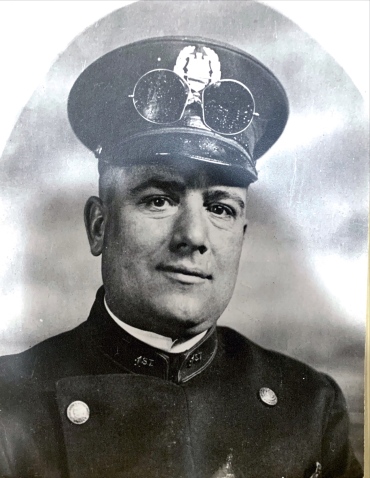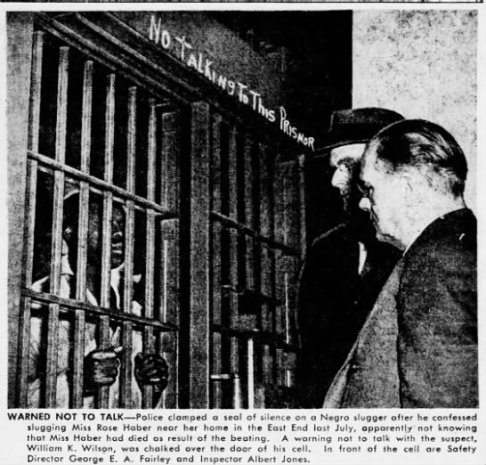Rose Haber, a 35-year old clerk returning home from work at McNulty’s Drug Store, was hit in the head “with a heavy weapon” (Pittsburgh Press, July 14, 1941) and robbed of her purse after she exited a bus in front of 5749 Jackson St. in East Liberty on the night of Saturday, July 12, 1941.

With the help of bystanders, Haber made her way to a nearby drugstore where she reportedly talked about her assault and assailant with the police and others.

Transported to Shadyside Hospital, Haber reportedly “gave police a more complete description of her assailant” the next day (Pittsburgh Press, July 14, 1941). Though she was initially thought to be recovering, Haber died that afternoon.

Little is known about what Haber was able to report. Surviving police and coroner records do not include a description of her assailant. Initial newspaper accounts provide conflicting information. In its first story on the attack, the Pittsburgh Press reported that Haber told police that her assailant was a “white man” wearing “light colored slacks, a white shirt and a sailor straw hat” (Pittsburgh Press, July 14, 1941). Henry Mazer, a passerby who came to Haber’s aid after the assault, is reported to have provided a similar description of her assailant. That day’s Pittsburgh Post-Gazette reported the same description of her assailant’s clothing but said Haber was unable to identify his race. The Sun-Telegraph’s initial account provided no description of the assailant.

None of the other bus passengers, the driver, or people on the street in the vicinity of the attack were able to provide a description off the attacker.
The next day, police learned of a witness. Ella Kennedy, a young woman who worked as a maid in the home of Herman and Rebecca Fineberg, had witnessed the assault from inside their home next to the bus stop and thought she would be able to identify the assailant. The description reported by the Sun–Telegraph (July 15, 1941) matched the description provided by Haber. That Kennedy reported seeing the man’s face and that his race was not mentioned in the story likely indicates that the man was white. A positive identification of a Black offender would surely have drawn much more attention; a supposition supported by subsequent accounts provided by Kennedy.
With all the elements of a panic – an unsolved, late night, stranger-based murder of a white woman in a residential area – and other similar unsolved crimes in the area, police were under intense pressure to make an arrest.
In the weeks after the attack, police questioned and released at least six men suspected in the attack. Meanwhile, additional purse snatchings were reported in the area. In every case, newspaper accounts identify the assailants as Black.
The first big break in the case came in September, when police arrested and held Hoy Kenneth Houck,** a white man who became a suspect due to his commission of a series of similar assaults of women in State College, Bellefonte, and Lock Haven, Pennsylvania beginning in December 1940.
Though some newspaper reports indicated murder charges were filed against Houck, the “natty dresser” was ultimately released after police were unable to overcome his alibi that he was not in Pittsburgh at the time of the killing.
In February, 1942, seven months after the murder, suspicion fell briefly on Raymond Dumont, also white, who had assaulted a woman in McDonald, Pa. Ella Kennedy told police “she was positive” he matched the description of the man she had seen assault Haber (Pittsburgh Press, February 4, 1942). Dumont was also released due to a lack of evidence.
Pressure continued to mount. Then, on March 19, 1942, 20-year old William Kennie Wilson, a homeless, Alabama-born Black migrant being held for assaulting Victoria May on the North Side days earlier, confessed to killing Haber after three days in custody. Lead investigator Albert Jones indicated that police were “baffled” and “puzzled” by Wilson’s confession and reenactment of the crime, which did not match the “known facts” of the case (Pittsburgh Sun-Telegraph, March 19, 1941).

A second reenactment conducted a week later resulted in an “entirely different” scenario, compounding the confusion of police (Pittsburgh Sun-Telegraph, March 26, 1942).

Also troubling was that news reports of May’s assault had described her assailant as a “giant colored man” (Pittsburgh Post-Gazette, March 19, 1942). Wilson’s World War II Draft Registration card, filled out a month before his arrest, listed him as 5’7” and 157lbs.

- image from the Pittsburgh Press, March 19, 1942. Notice how small Wilson is compared to the men with whom he is speaking.
Indicted on April 15, Wilson entered a plea of not guilty on May 4, before withdrawing it and pleading guilty the next day after a church missionary interceded. He also pleaded guilty to other robberies, rapes, and assaults, clearing numerous serious crimes for police.
William Wilson was formally sentenced to death by a three-judge panel on May 14. His defense plea for mercy, during which his attorney, P.J. Clyde Randall, told the court that “this defendant has the mind of a child….I don’t mean he’s insane. This boy doesn’t have the same viewpoint of other youths his age,” was rejected.
Poor, alone, disadvantaged in numerous ways, and without benefit of trial, appeal, clemency review, or competency hearing – a remarkable lack of due process for a death penalty case – William Wilson was executed on August 10, 1942. He was the only Allegheny County resident executed during American involvement in World War II.
Having carefully investigated this case, I believe there is a compelling argument to be made that the State of Pennsylvania executed an innocent man.
* Wilson’s family had moved north from Alabama to the coalfields of Cecil, Washington County, when he was a child. Raised in company housing in the coal town of Lawrence, Wilson moved by himself to Pittsburgh in the late 1930s, where he lived on the streets or in the Catholic Worker-led St. Joseph’s House of Hospitality in the Hill District.
** Houck’s connection to Haber’s murder is intriguing. Beyond his physical similarities to the descriptions provided by Haber and Kennedy, his conviction for a series of remarkably similar crimes occurring at the same time in central Pennsylvania (and his suspected ties to two unsolved murders of women in State College), and his regular work-related travel to Pittsburgh at the time of Haber’s murder, he was arrested for purse snatching in Baltimore after being released from prison in Pennsylvania. He was also arrested for child molestation in Florida in 1961. Houck died in Florida in 1991.









My name is Mark Kahn and Rose Haber (the victim of the crime) was my great aunt. I’ve recently been collecting newspaper articles about this crime, and noticed that some of the stories refer to Wilson’s “child-like mind” and describe a timeline with a relatively quick execution following the crime. It seems to call into question whether he knew what he was confessing to and whether or not the process was entirely fair. Do you have any reason to question his guilt or the fairness of the process?
LikeLike
These are very good questions. Indictions of Wilson’s limited intelligence, the racist media tropes of large and powerful Black men, the inconsistencies between his confession and the “known facts” of the case, and the fact that the state’s case was never tried are all troubling. Without a trial record or police records (which are not available), answering these questions is difficult. What I plan to do is to try to find the case coverage provided by the Pittsburgh Courier, Pittsburgh’s famous Black newspaper. That coverage is not available at the online source I use.
LikeLike
Mr. Kahn,
As I have continued my research on the Wilson case, I have become more concerned that William Wilson was innocent. If possible, I would be interested in communicating with you about this matter. If you are interested, you may contact me at lofquist@geneseo.edu. Thank you, Bill Lofquist
LikeLike
You may be interested in my book “Nittany Nightmare: The Sex Murders of 1938-1940 and the Panic at Penn State,” which cites your website and further explores the connection between the Haber murder and Hoy Houck. What happened to Willie appears in hindsight to be no less than a railroad job by authorities. The difference in treatment of the white Houck and the African-American Wilson for their similar crimes by judges is also eye-opening.
I want to thank you, Mr. Lofquist, for your fine work that helped me round out my own story in the book.
LikeLike
Thanks for writing. I recently bought and read your book after seeing a reference to it in my research on Houck. The information you provided was very helpful. Thank you. As I continue my research on the Wilson case, I become more convinced that he was innocent. I will be updating my website to reflect that new research soon.
LikeLike
Awesome I am glad it was helpful! I would have loved to have talked to Houck…There was a lot going through that guy’s head I would like insight into.
LikeLike
Hi Derek,
If you see this message and are available to talk, please contact me at lofquist@geneseo.edu
Thank you,
Bill
LikeLike